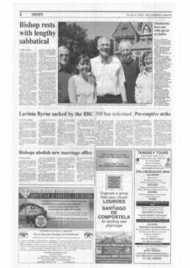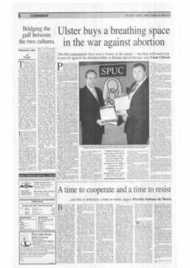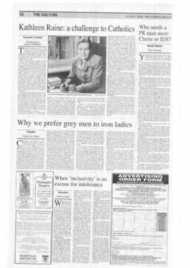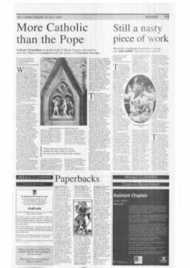Page 10, 18th July 2003
Page 10

Report an error
Noticed an error on this page?If you've noticed an error in this article please click here to report it.
Tags
Share
Related articles
Rubbing Salt Into The Arts
Word Of The Poet
`every Person Is A Special Kind Of Artist'
Was Shakespeare A Papist?
Theodore Ma.ynard
Kathleen Raine: a challenge to Catholics
Counter Culture
Stratford and Leonie Caldecott
....,
The poet Dr Kathleen Raine, %;iio died on 6 July at the age of 95, should not be dismissed too quickly, aot her influence underestimated. She converted to Catholicism and then withdrew, but her reasons for doing so are interesting, and her life story and writings tell us much about the failure of Christianity in our time.
This is not intended as an obituary, and so will not contain a detailed summary of her life, but a biographer world probably make much of an idyllic and inspirational Northumberland childhood. This awakened her to the possibility of experiencing heaven whilst still on earth; but it remained necessarily only a glimpse. Her first experience of love was blighted by her father's obstruction of it (he "cut something from my soul." she wrote). From that time onwards she would have to struggle to find and keep love and happiness, through a series of tempestuous affairs, culminating in an intense but "Platonic" relationship with the homosexual writer Gavin Maxwell (Ring of Bright Water). That relationship ended with her formally cursing him under a rowan tree, and she seemed to believe the curse afflicted them both. for after his death from cancer in 1969 her poetry often reflects the agony and guilt it engendered.
The obituaries of this truly great British poet and important Blake scholar state that a new phase of her life began in the early 1980s, with her foundation of the journal Temenos. It was at this time that we made her acquaintance, as new and somewhat naïve Catholics: in fact, we met when she was planning her journal and we were hoping to start one of our own. We agreed to exchange subscriptions if we ever achieved our goal: a commitment she honoured even though we were not able to reciprocate for another two decades. (When we did she responded graciously and sweetly.) The Temenos experiment was hardly mainstream, and it was funded at lit st by the sale of
paintings and occasional donations, for Dr Raine was not wealthy. But she was surrounded by friends, and the sufferings and religious searching of her earlier life seemed now to bear fruit in a cultural movement centred around her flat in Chelsea. where her superb hospitality is remembered by everyone who knew her. David Gascoyne, Vernon Watkins, Jeremy Reed, Thetis Blacker, George Mackay Brown, John Michell, Peter Redgrove, John Tuve= and Keith Critchlow were among those who published regularly in her journal, and after ten years the movement found its patron in the Prince of Wales, who offered hospitality for the Temenos Academy after 1999.
Temenos (a Word that means "sacred precinct") was an affirmation of the reality and importance of the Sacred expressed through the "Imagination" — which is to say through the arts understood as disciplined, visionary experience. It was the latest flowering of a long symbolist tradition, entangled with Christianity yet tending often to heterodoxy, from Yeats
and the contemporary highbrow "occult" establishment through the Romantic poets back to Blake (of course) and the Platonist Thomas Taylor. I suppose in the distance lay the heresies of Gnosticism, and she was in fact much taken with twentieth-century Gnostics like Carl Jung and Henri Corbin. The latter opened up for her the world of Islamic theosophy, and partly as a result of such influences Temenos was spectacularly inter-religious, probably drawing more from Vedic, Kabbalistic and Sufic sources than from orthodox Christianity. The frozen abstractions of theology (as she saw them) were not what appealed to her: she knew that the world needed truth, goodness and beauty, but she could find these only in the "Arts of the Imagination", in mythology and the poetic arts, freed from the prosaic limitations of dogma. She saw our culture as desperately shallow and degraded, and in need of a reawakening to other levels of reality. Poetry. capable of evoking the experience of those other levels, possessed the healing force needed by our decadent civilization.
With Kathleen's rebellion against the rationalism and materialism of the European Enlightenment we had much sympathy, although our own search had led us to find a home for art and imagination within orthodox Christianity itself. Corbin never understood the radical paradox of the Incarnation, and Kathleen perhaps did not grasp the sacramental cosmology of the Catholic Church — a Church that for a while captivated and later repelled her. She could see that people were looking for the richness of symbolic consciousness, for a wisdom that transcends time. But, shockingly, Kathleen Raine CBE could not find that neglected contemplative dimension within "institutional Christianity".
In a way she represents a host of intelligent, imaginative people lost to the Church because we have forgotten the importance of symbolism and gutted the liturgy. Love is reduced to sentiment and the Gospel to moralism. If we are ever to succeed in calling such people back to their home in the Church, it will he by showing them the living wisdom they have been busy seeking elsewhere. It will not be by preaching at them, but first of all by studying and listening to them; for in order to arrive at our destination we must go on a journey together.
blog comments powered by Disqus















